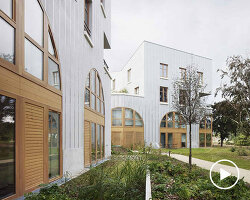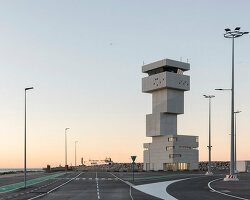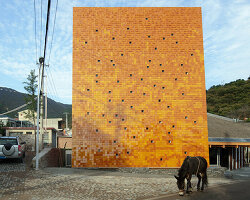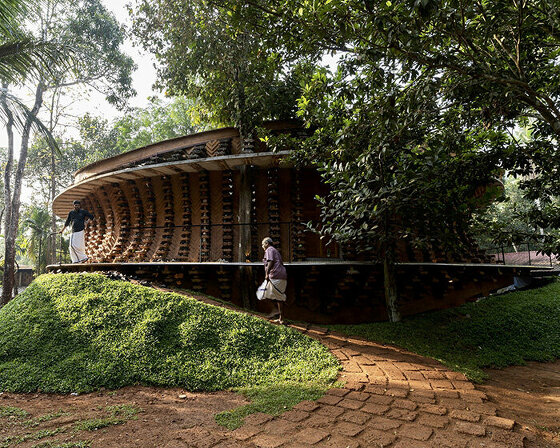SDIS & CIS by LAN architecture is part of a rennes development
The SDIS & CIS (fire and rescue center) by LAN Architecture is becoming the cornerstone of a new development in Rennes, Frances, dubbed the Bau-Chardonnet ZAC. It is, more specifically, part of the continuation of the Vilaine Amont François Château urban requalification outlined by Audiar (Rennes Urban Planning Agency) in 2009. Located at the crossroads of two major axes, this 7,800 sqm landmark assumes the role of ‘prototype’, the first model of a series of future buildings, organized as an extension of the existing town. Its strategic location led to a two-part design. On the one hand, the studio articulated the northern fringe of Avenue François Château with the public space of the East-West axis, particularly with the promenade along the banks of the Vilaine. On the other hand, it created a dense urban facade on Avenue François Château to elevate the city-like character. This approach balances the urbanization on either side of the Vilaine.
Ultimately, this first building of the future Baud-Chardonnet ZAC becomes the symbol of the entrance to the city of Rennes. ‘Because of its scale and its impact on the future life of the district, this project forms the striking image of renewal,‘ writes LAN Architecture.
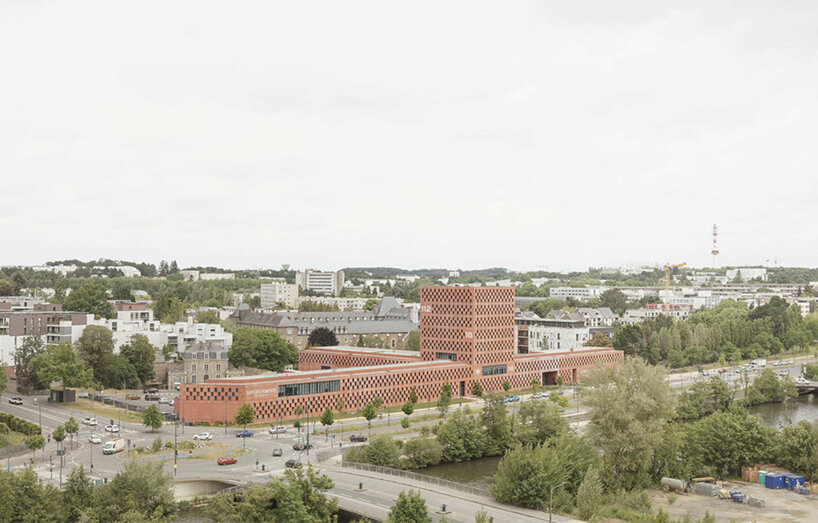
images © Charly Broyez, Schnepp Renou
merging two programs via a vertical circulation core
The specificity of the Rennes project by LAN Architecture (see more here) lies in the fact that it joins two programs, each connected by an internal vertical circulation core with its amenities. The Administrative Service Départemental d’Incendie et de Secours (SDIS) coordinates the interventions of the department’s fire and rescue centers and is in charge of risk analysis via its emergency call processing center (CTA-CODIS). At the same time, the Centre d’Incendie et de Secours (CIS) mainly carries out rescue missions. The T-shape of the building has optimized the flow of users within the building and their travel time. The junction point between the wings of the base and the tower forms the central node that links the CIS and the SDIS with all the shared spaces. Thanks to this vertical core, the spatial organization of the program puts each of the services in immediate proximity to the others.

SDIS & CIS in Rennes by LAN Architecture
using a facade module for interior flexibility
The post/beam structure and the choice of a facade module facilitate a possible reconfiguration of the building to adapt to a structure in solid evolution. A common facade for all spaces proved to be the most effective alternative to satisfy the program’s functionality. A repeated window module allows a high degree of flexibility in the interior design. Each office has a minimum of six windows, two at a lower level, two at seat height, and two at standing height. On the southern facade, offering views over the Vilaine, specific openings have been treated as curtain walls according to the functions of the adjoining spaces. During the day, these openings give an intense view of the interior, while at night, everything is reversed. ‘The play of openings in the facade transforms the volume into a luminous lantern. The building becomes a night light that bears witness to the permanent dedication of the fire brigade,’ shares LAN Architecture.
Each facade module, 1.35 meters wide, is divided into six elements: three windows and three solid sub-modules. Every 1.35 meters, we thus find two view situations presented in the above sections: oblique framing towards the sky or the landscaping below; framing towards the landscape at the view level. The repetition of the module throughout the facade allows optimal flexibility in the interior design of the program and becomes the symbol of a new identity in Rennes.

the T-shaped complex is part of the Bau-Chardonnet ZAC development
LAN architecture’s t-shaped distribution
The SDIS program highlights the proportion of the programmatic void to the full. While the building results in approximately 3,900 sqm of built area, the hole composed of a maneuvering area, a turning area for emergency vehicles, and parking for light cars represents 11,700 sqm of floor space. This proportion between full and empty space requires the building to be aligned to create an urban front on Avenue François Château and to create an interface to the rear of the building, where the site’s entire road system concentrates. The two-story building volume stretches along the whole length of the plot.
The SDIS sits in the west wing; on the ground floor are the delivery locks and the reception area for visitors to the medical practice. In addition, there is the office tower, which houses the SDIS services. This forms a built emergence in the urban landscape, animating the skyline of the new development of the district and offering a quality of use and views. The entire SDIS operations department occupies the four levels of the tower (R+2 to R+5). The CTA/CODIS located on the tower’s first level (R+2) is directly linked to the restaurant and relaxation areas below. The human resources department (R+6) and the general management (R+7 and R+8) have generous ceiling heights, double-height space, and an R+8 mezzanine level.
The CIS, meanwhile, is developed in an L shape on the west and north wings. The administrative center, storage, changing rooms, sports hall, and associated changing rooms are located on the ground floor, while the accommodation, relaxation, and catering areas are on the first floor. A wide horizontal circulation connects the heart of the project to the weight room and the sports hall on the ground floor.

a repetition of the facade module for greater interior flexibility
The program’s major spaces and issues are concentrated around a central vertical axis that serves the entire building. The junction point between the three wings of the base and the tower forms the heart of the project; it guarantees optimal travel times between the two programs and their various groupings. This central node makes it possible to link the CIS and the SDIS with all the shared spaces: a common hall, shared meeting spaces, grouped restaurant services, and the terrace facing south on the Vilaine.
Due to its central vertical core, the spatial organization places each of the services at close proximity. The SDIS operations department occupies the tower’s first four levels; on the second floor, the CTA/CODIS is directly linked to the restaurant and relaxation areas below. On the R+6 level, the human resources department is located on the R+7/R+8 level; the general management has a generous ceiling height and a double-height mezzanine floor on the R+8 level.
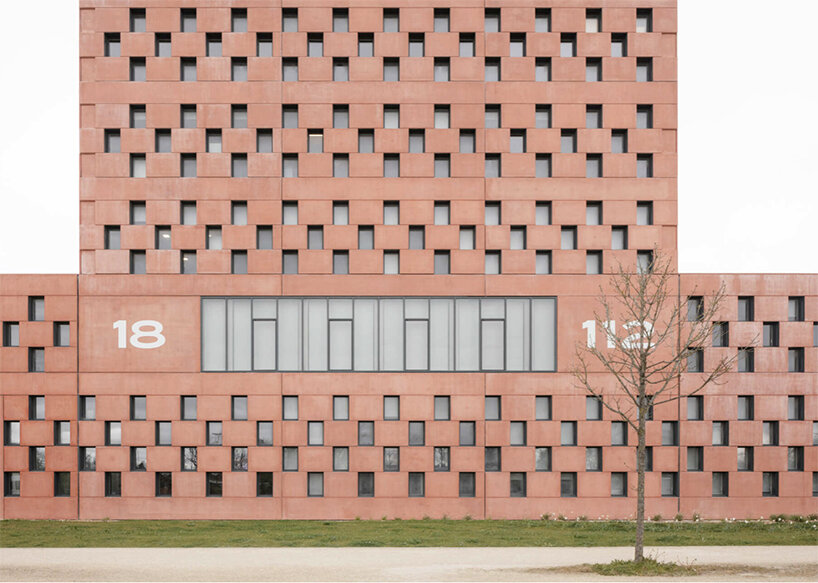
window module
Lastly, the entire public space of Avenue François Château in Rennes is being redesigned to accommodate a new dedicated public transport infrastructure. The exclusive right-of-way consists of two two-way lanes. The emergency exit is 52 meters from the southeast corner of the plot, with access to the two-way bus lane via a traffic light system operated by the fire service. The return of the intervention is carried out from the South by avenue François Château (by turning right) and from the West by rue Moulin de Joué, by a dedicated circulation along the limits of the northern parcel.


powered by a vertical circulation core

tower of the SDIS & CIS complex in Rennes by LAN Architecture

detail of the corner of the desk

gymnasium







project info:
name: SDIS & CIS / Fire and Rescue Center
location: Rennes, France
architect: LAN Architecture | @lan_architecture
lead architects: Benoit Jallon, Umberto Napolitano
client: Conseil Général d’Ille et Vilaine | @ille_et_vilaine
structure & M.E.P: Terrell / Philippe Galichet
surveyor: BMF / Renaud Chanceaulme, Stéphane Loustalet
control office: Qualiconsult / Yoann Le Fur
CSPS: Office Cobati Rennes / Yvon Le Cunff
acoustic: Lamoureux
VRD: AVR / Youssef Rizk, Adrien Allenbach
OPC: Audatis et Samuel Berrée
photographers: Charly Broyez, Schnepp Renou
area: 8,510 sqm (buildings) + 9,468 sqm (exterior)
ARCHITECTURE IN FRANCE (607)
FACADES (234)
LAN ARCHITECTURE (32)
PRODUCT LIBRARY
a diverse digital database that acts as a valuable guide in gaining insight and information about a product directly from the manufacturer, and serves as a rich reference point in developing a project or scheme.




